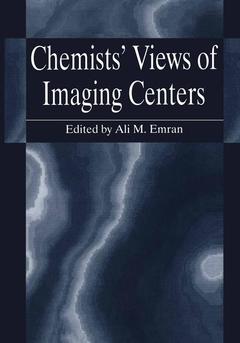Chemists’ Views of Imaging Centers, Softcover reprint of the original 1st ed. 1995
Langue : Anglais
Coordonnateur : Emran Ali M.

To continue the support for the growing trend of chemistry involvement in nuclear medicine, the Division of Nuclear Chemistry and Technology (DNCT) of the American Chemical Society (ACS) planned for a symposium to cover this aspect. This was expressed in arequest to me, as a member of the Program Committee, to organize a symposium on topics related to nuclear and radiochemistry applications to nuclear medicine. Realizing the growing interest in imaging, specially with positron emitting radioisotopes, I invited several colleagues to study with me the idea of imaging centers and the involvement of chemists in their structure and function. The formulated Organizing Committee supported this idea which evolved in proposing an extended international symposium to be held in conjunction with the 206th ACS National meeting in Chicago, Illinois, U. S. A. on August 22-27, 1993. The following are the members of the Organizing Committee: Jorge R. Barrio, Ph. D. Thomas E. Boothe, Ph. D. J. Robert Dahl, Ph. D. Robert F. Dannals, Ph. D. Bruce R. Erdal, Ph. D. Mark M. Goodman, Ph. D. George W. Kabalka, Ph. D. James F. Lamb, Ph. D. Ronald G. Manning, Ph. D. Henry C. Padgett, Ph. D. Roy S. Tilbury, Ph. D. Steven W. Yates, Ph. D. and Ali M. Emran, Ph. D.
Technical, Administrative and Organizational Issues in Clinical PET.- 1.1. The Role of Chemists in Developing Radiopharmaceutical Applications, Industry and Regulations: Introductory Remarks.- 1.2. The Basics of Positron Emission Tomographic (PET) Imaging.- 1.3. PET: A Biochemical and Physiological Measuring Modality.- 1.4. Layout and Planning of a University Hospital Clinical Cyclotron/PET Facility.- 1.5. Evaluating The UTMCK PET Center: An Organizational and Financial Analysis.- 1.6. The European Concerted Action in PET: Activities in Radiochemistry.- 1.7. Pharmacy Practice and PET.- Regulatory Issues in Clinical PET.- 2.1. Clinical Imaging Centers: The Role of State Radiation Control Programs.- 2.2. PET: The Governmental Reimbursement Perspective.- 2.3. Review of Radiopharmaceutical IND’s and NDA’s.- 2.4. Compliance with Good Manufacturing Practice.- 2.5. The Regulatory Process: The Institute for Clinical PET’s Experience.- 2.6. USP Activities and PET Radiopharmaceuticals.- 2.7. Managing the Obstacles in the Path of Regulatory Approval of PET.- Pet Related Equipments Specifications and Selection.- 3.1. Laboratory and Cyclotron Requirements for PET Research.- 3.2. Truly Frugal PET: Is It Possible?.- 3.3. RFQ’s for PET Radionuclide Production.- 3.4. Strategies in Synthesizing Short-Lived Radiopharmaceuticals for PET.- Quality Assurance/Quality Control and Related Issues.- 4.1. Role of Current Good Manufacturing Practices in Establishment of Quality Assurance for In-House Radiopharmaceuticals.- 4.2. Quality Control for 11C and 18F Radiopharmaceuticals in the Research Environment.- 4.3. Trend Analysis of Quality Control Data.- 4.4. Quality Assurance of Radiolabelled Proteins, Peptides and Anti-Sense Oligonucleotides.- 4.5. Reactor Isotope Quality Assurance.- 4.6.Analytical Instrumentation in the QC of PET Radiopharmaceuticals.- Radiopharmaceuticals for Biomedical Research and Imaging.- 5.1. Development and Production of Radiopharmaceuticals for PET.- 5.2. New PET Tracers for Cerebral Dopamine: Should 6-[18F]-Fluoro-L-Dopa Be Replaced?.- 5.3. Design, Structure-Activity, Labelling and Purity in Development of Receptor Interacting Radiohalogenated Tracers.- 5.4. Halogenated Benzamides as Ligands for Cerebral Dopamine Receptors.- 5.5. Development of Fluorine-18 Radiopharmaceuticals for Dopamine Neuroreceptors.- Applications of Various Nuclides.- 6.1. Radionuclides and Their Applications in Oncology Research.- 6.2. Positron Emitting Radiotracers for in vivo Plant Research.- 6.3. Production and Applications of 123I-Labelled meta-Iodobenzylguanidine (123I-mIBG).- 6.4. Chemistry, Radiochemistry and Applications of Potassium Isotopes.- 6.5. 19F-MR Characterization of Fluorinated Proteins and Relaxation Rate Enhancement with Gd-DTPA for Faster Imaging.- 6.6. Recovery of Bi-213 from an Ac-225 Cow: Application to the Radiolabelling of Antibodies with Bi-213.- Targetry and Precursor Chemistry.- 7.1. Application of Fullerenes in Biomedical Imaging.- 7.2. High Pressure H218O Target for the Production of [18F]-Fluoride Ion.- 7.3. Requirements for Production Targets for Middle-Energy Cyclotrons.- 7.4. Synthesis of Fluorine-18 Labelled Compounds for Brain Imaging.- 7.5. Solid Phase Reagents in Radiosynthesis.- Radiotracer Syntheses.- 8.1. Flourine-18 Labeling of Radiopharmaceuticals for PET Studies: Main Aspects and Problems Encountered in Chemical Synthesis.- 8.2. Distribution and Quantification of 18F-Activity Produced via 20Ne(d,?)18F Reaction in a Gas Target.- 8.3. Twenty Years as a Chemist in the Service of a PET Center.- 8.4. ClinicalBlood Flow Measurements with 15O-H2O and Positron Emission Tomography (PET).- 8.5. Radiofluorinated Enzyme Probes of Dopaminergic Function.- 8.6. Routine Production of [18F]-F2 from 11 MeV Proton-Only Cyclotron and Its Use for 18F-Tracers for Heart and Brain.- Automated Synthesis of Radiotracers.- 9.1. The Hammersmith Philosophy for PET Chemistry Automation.- 9.2. The Use of Microwaves for the Automated Production of Radiopharmaceuticals.- 9.3. Reverse Robotics: Interactive Machines for Controlling People in a Complex Laboratory Environment.- 9.4. Automated Radiochemistry through Transducers: Light from the Far Side.- Chiral Syntheses and Separations.- 10.1. Homochiral Radioligands for PET: Aspects of Asymmetric Synthesis, Analysis and Behavior in Vivo.- 10.2. Fluorinated Tropinyl Esters for Application with PET.- 10.3. Preparation and Examination of Labeled Stereoisomers in Vivo by PET.- 10.4. Radiolabelled Tamoxifen Analogues for Imaging Breast Cancer with SPECT.
Date de parution : 05-2013
Ouvrage de 537 p.
17.8x25.4 cm
Thème de Chemists’ Views of Imaging Centers :
© 2024 LAVOISIER S.A.S.
